Sakai's experienced artisans turn Hokkaido's kelp into a delicacy.
Kombu Road and Sakai's Kombu
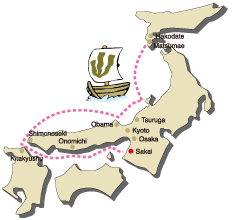 The existance of a transportation route for kombu from Hokkaido played a major part in developing the kombu processing industry in Sakai.
The existance of a transportation route for kombu from Hokkaido played a major part in developing the kombu processing industry in Sakai.
"Kombu Road", as it was called, was the route by which the kombu was brought from Hokkaido to Sakai. It followed the more calm marine route along the Japan Sea from Hokkaido to Tsuruga, Obama, Shimonoseki, Osaka, and finally Sakai.
At first, kombu was only shipped as far as Tsuruga and Obama. It was then carried across land to Otsu, from where it was transported to Osaka by boat using the Yodo-gawa River.
By the beginning of the 18th century, the shipping route was extended to Osaka and Sakai, and subsequently a large volume of kombu started to arrive in Sakai.
A full-scale kombu processing industry started in Sakai at the same time.
At its peak, around the 1920s, there were some 150 kombu processing plants in Sakai.
Extremely thin sheets and fibers of kombu called "tororo" and "oboro" are major products of the kombu industry in Sakai today. Tororo kombu is machine processed, while a skilled artisan manually scrape-shaves each piece of oboro kombu to preserve its quality.
How Tororo Kombu is Made
-
Soaking
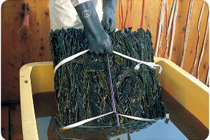 To soften and to add taste to the kombu, it is soaked in rice vinegar for about 2 hours.
To soften and to add taste to the kombu, it is soaked in rice vinegar for about 2 hours. -
Cutting
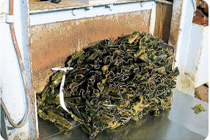 The kombu is cut into a suitable size for pressing.
The kombu is cut into a suitable size for pressing. -
Removing Sand
Sand is removed by a vibrating machine. -
Adding Flavor
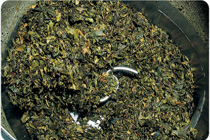 The kombu and various seasonings are mixed together in a mixer.
The kombu and various seasonings are mixed together in a mixer. -
Pressing
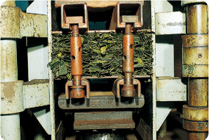 The kombu is pressed into a 60 kg square block.
The kombu is pressed into a 60 kg square block. -
Shaving
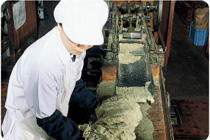 The kombu block is vertically shaved with an automatic shaver. Each machine can produce approximately 100 kg of tororo kombu in one day.
The kombu block is vertically shaved with an automatic shaver. Each machine can produce approximately 100 kg of tororo kombu in one day.
Useful Tips about Kombu
Kombu is a health food known to reduce high blood pressure and fatty tissue. Kombu also contains iron and such alkaline minerals as potassium, sodium, and calcium.
Manually Shaved Oboro Kombu
 After the sand is removed from the unprocessed kombu, and it has been soaked in rice vinegar to soften and add taste to, each piece of kombu is carefully scrape-shaved into 0.05 mm sheets with a special scrape-shaver.
After the sand is removed from the unprocessed kombu, and it has been soaked in rice vinegar to soften and add taste to, each piece of kombu is carefully scrape-shaved into 0.05 mm sheets with a special scrape-shaver.
The white part left over is further processed and used as a thin covering for battera, a kind of boxed sushi that is popular in Osaka.
Various Types of Kombu
| Name | Color | Features |
|---|---|---|
| Ma Kombu | Dark brown | Thick and wide. Delicate taste. The finest quality kombu. |
| Rishiri Kombu | Blackish dark brown | A little harder than ma kombu. Salty and quite tasty. The second best quality kombu. |
| Enaga-oni Rishiri-type Kombu |
Brown | Also known as Rausu kombu. Has a contrasting taste to ma kombu. |
| Mitsuishi Kombu Hidaka Kombu |
Dark green | Soft and easy to cook. Used to make kombu-maki (rolled kombu). |
| Naga (long) Kombu | Dark gray | 6 - 15 meters long. Not very sweet in taste but the thicker pieces are quite tasty. |
| Atsuba (thick leaved) Kombu |
Black | The inside is white and contains a yam-like substance. Tastes bitter rather than sweet. |
| Hosome Kombu | Black | The inside is white. The sweet taste fades quickly. |
[Manufacturers' Associations]
●Sakai Kombu Processing Association
C/O Nakano Bussan Co.,Ltd.
14-20 Daisen-nakamachi Sakai-ku, Sakai 590-0801
Phone: (072) 241-9505
website







